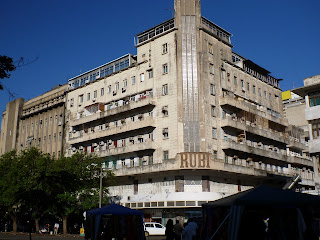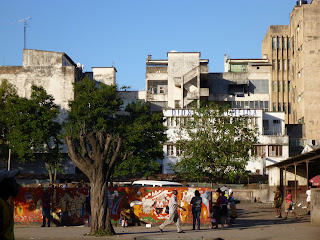I feel dizzy was all she said. Before
that, there were no signs. 20 minutes later she was semi-conscious
and on her way to the hospital. It's amazing how quickly our bodies
can shut down.
Friday, my last full day in Tofo. We'd
booked a double dive trying to make the most of the day. The
volunteer coordinator wasn't so happy that we'd taken things into our
own hands as were supposed to all be going out on the same ocean
safari as the official end to our research trips, but we didn't care.
By this point, we knew we enjoyed diving a lot more than just
driving around in the boat hoping to see something and I was on the
hunt to see a Manta Ray, something which had eluded me all month.
It was a beautiful day- sunny and warm.
The rest of the week had been rainy and overcast so, it was nice to
see the sun again. The boat launch went well. You never know just
how it's going to go. Sometimes the boat gets pushed back onto shore
by waves, sometimes the boat is too far in the water for me to jump
up, but this day everything went smoothly.
On the trip were two German men whose
names I didn't bother to learn, an Isreali guy who was just
completing his open water, so, nice enough but couldn't dive worth
shit, Nicole, Dymphna, myself and the crew- Nick the owner, Lobo a
dive master and Neo the skipper. A nice little group heading out for
a couple of dives with a little ocean safari in between to look for
whale sharks. The first site we went to was Outback which is so
named because it's one of the farthest sites away. It takes about
35-45 minutes to get there by boat during which time you're wearing
your wetsuit. By wearing a wetsuit you basically turn your body
into the inside of a tire. You encase yourself in 5mm of black
rubber, which is fine if you're in the water, but sitting in the
boat, in the sun, it's stiffling to say the least. We complained
about being hot and took turns dumping water down each other's suits
and even got to swim with a whale shark on the way to the site- a
nice treat.
Outback had seen a lot of action in the
last week. A lot of mantas had been in the area as well as small
eyed stingrays and other oceanic wonders. However, the current had
also been a little crazy lately so we weren't sure what we were going
to get. It turned out that that day there was a lovely current,
moving in the right direction so we were able to glide gently around
the reef and enjoy the view. It was a beautiful dive, unfortunately,
no mantas.
Back on the surface, the sun was still
shining as we enjoyed our incredible sandwiches. It's amazing how
after having a limited diet for a few weeks, something as simple as a
turkey sandwich can taste gourmet. Sandwiches, coco biscuits and
bananas finished it was off on the hunt for a whale shark. It took
us a while, during which time we were entertained by the the
seasickness of one of the German guys. I know it's not nice to laugh
at someone else's pain, but this man did nothing by complain, so
watching him so obviously suffering just made us laugh. We
eventually found one, had a lovely swim and it was off to site two.
Our second dive was at a site called
Giant's Castle. Another popular site with a reputation for whale
sharks. This dive did not go quite as smoothly. There was a fairly
strong current and it was difficult to get down to the reef. It was
especially difficult for me because I was having a hard time getting
my ears to equalize so, poor Lobo had me hanging off the buoy line
for a significant amount of time, which is definitely not easy. I'm
not sure if my ears eventually equalized or if I just blew an ear
drum, but we might explore that one a little later. I did make it
down to the bottom though and we let the current direct the dive
every now and then holding on to the reef so that you could actually
see something. I like diving with a current because in a strange
way, it makes you slow down because it forces you to look closer at
the reef. You have time to sit and look at the small things that are
directly in front of you. Because you need to hold on, you can focus
on that one place and see all the little shrimp, nudibrank, coral,
lobsters and a million other things that you would otherwise miss.
On this particular dive, I came across a lovely little pinnacle
covered in shrimp, a moray eel and a lobster. Awesome.
And that was it. My diving in Tofo was
over. We headed home, had an uneventful landing (which is good
because sometimes they can be really rough) and headed up the beach
to the dive centre to clean up our stuff and go home for a nap.
About halfway up the hill, Dymphna stopped. This is not Dymphna.
She is tough; she is strong; and she is proud. She would never admit
to being tired or not being able to keep up unless something were
very wrong. I was able to get her to sit down on the stairs for a
few minutes. She was dizzy and weak and feeling nauseous. Being a
great sufferer of heat related illnesses, I recognized the symptoms
right away. After a few minutes, she was able to get up and made it
to the top of the stairs where there is a big umbrella and some
chairs. We got her some water and rehydration salts but she seemed
to be getting more and more tired. Still not ready to admit that
anything was truly wrong, the panic set in when her right arm went
numb. It was at this point that we all realized this was far worse
than we had thought. Nicole ducked into the dive office to ask for
oxygen while I worked at keeping Dymphna calm. She still had her
wetsuit halfway on which meant that from the waist down she was still
heating up. Nick grabbed ice which Nicole held to the back of her
neck, Steve called over the 'doctor', I started pouring water over
her legs and someone else started fanning her with a clip board. She
sat slumped, her right arm dangling and her energy just fading away.
We tried a couple of time to get her to walk to the dive centre where
there was a couch for her to lie down on out of the sun, but she
couldn't walk. Nick drove the pickup over so that she could just
climb into it, but when we got her to stand, she couldn't move her
feet. At this point, she started to slip in and out of
consciousness. There would be moments where she could respond to
questions, and she would yell at the doctor as he yanked on her
fingers but then she would slump back down and not respond to
anything. It was time to get her into the shade and get the wetsuit
off. The great thing about a dive centre is there are always lots of
strong men around. Nick, Steve and a couple of other guys grabbed
various limbs and dragged her onto the truck. It wasn't pretty, but
it worked. She was driven into the shade, we got her wetsuit off,
and put a fan on her. She was breathing forced oxygen and we had her
packed in ice to bring down her core body temperature.
Now, I have to mention just how
interesting it was to watch the two owners of the dive shop deal with
the situation. Steve was very nonchalant and in between moments of
giving orders how to treat Dymphna, he was schmoozing clients and
helping them make plans for their trip. Nick, on the other hand was
like a worried father, running around from place to place getting
everything we needed. He got ice, he got a yoga mat to put in the
back of the truck, he got towels to wrap the ice in, he got a fan, he
filled water bottles...both were amazing and very in control.
Lying in the shade, she started to come
round. The doctor hovering over her, taking every opportunity to
wipe the sweat off her breast (you may remember mention of this
doctor in an earlier post where he was videotaping us as we put our
wetsuits on), he declared that her temperature was back to normal and
that we could start to get her ready to go to the hospital to which
point Dymphna declared “I am not going to the hospital.” At this
point we knew that she would be ok. The Dymphna that we knew and
loved was back. Encouraged by her remark, we started to tease her
and she responded with gusto even managing to pick out the right
finger to give the appropriate response.
It was time to get her to the hospital.
We grabbed some of her stuff, put her on a mattress and off she went
to get some good IV fluids. A couple of hours later she was home
with strict orders to take it easy and not do anything for the next
five days. The next morning she was back on Facebook talking about
her near death experience and I knew that she would be ok.
What was amazing was how fast it all
happened. She was fine during the dives. There were no symptoms on
the boat. We had no clue that anything was wrong and then it only
took about 10 minutes for her to loose consciousness. Just goes to
show how careful and aware you have to be. These things can happen
anytime, anywhere, to anyone- even those people who seem to be
invincible. The ironic part is that Dymphna had been looking after
all of us for the four weeks we were together. She was a vet and her
father a doctor, so medicine was in her blood. Any opportunity to
help someone and she was there. None of us thought that she would be
the one who would need the most serious treatment.
Now, I know that Dymphna wanted to make
my last day really special but really, a nice card would have done
just fine. I am glad that you're ok Dymphna and it really was an
incredible four weeks, but if you ever do anything like that to me
again, I will kick your ass! Thanks for making it so memorable.








